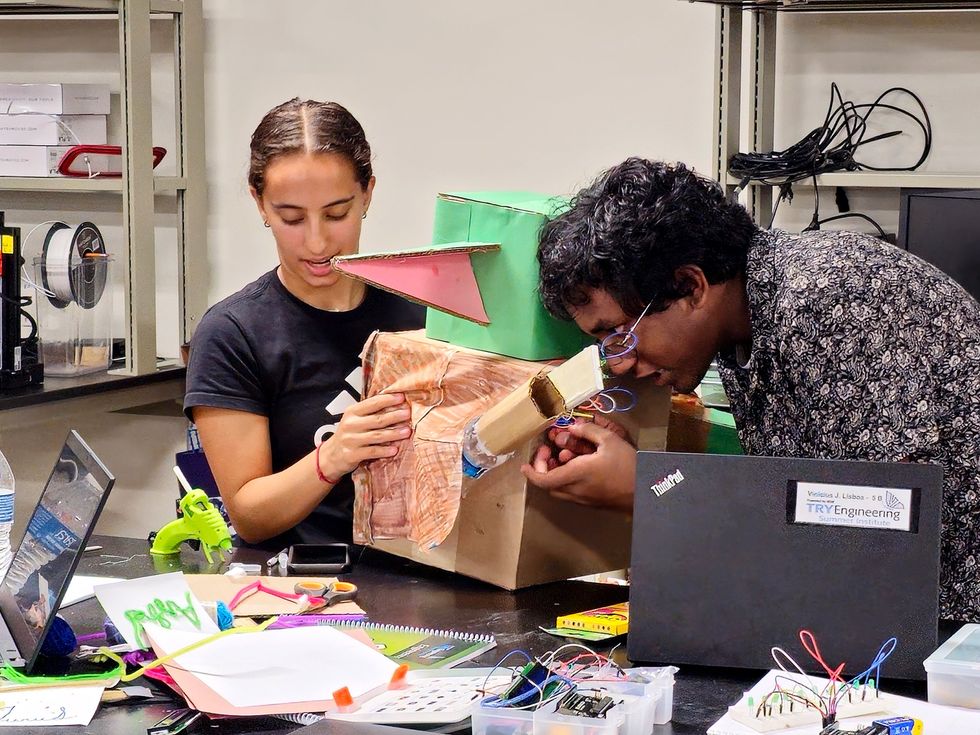“It’s probably the best way I could have spent my summer,” said a student who participated in this year’s IEEE TryEngineering Summer Institute. The 10-day camp for students ages 13 to 17 provides an immersive and fun approach to learning about engineering. The teenagers engage in hands-on activities, speak with working engineers, and make field trips to local engineering organizations.
In its inaugural year in 2018, 80 students participated; this year 330 attended.
This year’s group of students explored trending engineering technologies such as artificial intelligence and microcontrollers. The teens took a deep dive into the ethical issues that face engineers, as well as what to expect when pursuing higher education and a STEM career.
For their final group challenge, the students participated in an activity called Real World, Real Solutions. Working in small teams, they solved a problem and created a prototype using the engineering design process.
“Before I attended the summer camp, I was not sure if I was cut out to be an engineer,” one scholarship recipient said. “But after my wonderful experience at the IEEE TryEngineering Summer Institute, I am sure that this will be the right career path for me.”
Reminiscent of the TV show “Shark Tank,” on which business leaders often advise entrepreneurs, the students presented their projects to IEEE Pre-University Education Coordinating Committee volunteers, who provided feedback and guidance. The committee scored the teams’ projects based on the perceived demand for the final product or service, the students’ passion for their project, the engineering and technical design used, and the style and effectiveness of each presentation.
Three locations, one common goal
This year, the TryEngineering Summer Institute was held at the University of Pennsylvania, in Philadelphia; Rice University, in Houston; and the University of San Diego. There were two sessions on each of the three campuses.
University of Pennsylvania
Located in the University City section of Philadelphia, the Penn campus provided students with historical and cultural experiences. Some students visited the Boeing facility in nearby Ridley Park for a behind-the-scenes look at the aerospace manufacturing process. Others toured Philadelphia International Airport and spent time with an engineer responsible for keeping one of the nation’s busiest transportation hubs running smoothly.
The TryEngineering Summer Institute is “a great place to learn about the various engineering careers,” one Penn camper said. “I personally enjoyed the microcontroller lessons the most because I was able to combine my computer programming skills with my friend’s electrical skills to create something I wouldn’t have been able to make on my own. This program is an opportunity for exploring the different branches of engineering.”

Rice University
The students at Rice spent most of their lab time in the Oshman Engineering Design Kitchen, a space for undergraduate students to design, prototype, and deploy real-world engineering projects. The teens met with faculty members and devised solutions to engineering challenges such as building a hydraulic robot arm and creating a light sculpture. A highlight for the campers in Houston was a daylong visit to NASA’s Johnson Space Center. In addition to enjoying a guided, behind-the-scenes tour, they met with former astronauts, who explained the engineering design of their rockets and gave career advice.
The “TryEngineering [Summer Institute] was a summer game changer for my son,” one parent said. It “ignited his passion and expanded his horizons.”
University of San Diego
Students who attended the camp on the USD campus built gliders and tested their designs from the balcony of the building where they slept. They also worked in teams to address the Toxic Popcorn Design Challenge. The teams came up with a product and a process to save a city by safely removing “toxic” popcorn. They also toured the San Diego headquarters of Qualcomm, a wireless-technology company.
“TryEngineering is a fantastic place to learn about all facets of engineering,” one participant said, adding that it is “an invaluable resource, especially for students who don’t have access to engineering classes or a robotics team at their school.”
Scholarships from IEEE groups
An important component of the TryEngineering Summer Institute is the financial support students receive from IEEE groups. Thirty-one students were awarded assistance thanks to the IEEE Educational Activities Scholarship Fund of the IEEE Foundation.
“Before I attended the summer camp, I was not sure if I was cut out to be an engineer,” said one scholarship recipient who attended the camp in San Diego. “But after my wonderful experience at the IEEE TryEngineering Summer Institute, I am sure that this will be the right career path for me. Now that I have experienced all the disciplines of engineering, I am better educated in the field as a whole, and I have all of the information I need to choose a specific field of engineering to have a career in.
“To the people who funded my scholarship, I would like to thank you from the bottom of my heart. The only reason that I was able to experience a great city in California and become more independent while staying in college dorms is because of you.”
A special thanks goes to these IEEE organizational units, which provided funding for the scholarships: the Broadcast Technology, Communications, Computational Intelligence, Electronics Packaging, Industry Applications, Microwave Theory and Technology, Photonics, Power & Energy, Power Electronics, Robotics and Automation, Signal Processing, and Solid-State Circuits societies, as well as the Council on Superconductivity.
- Teen’s Pill-Tracking Device Attracts Interest From CVS Pharmacy ›
- This Stevens Institute of Technology Student Got a Head Start in Engineering ›
- IEEE’s Honor Society Gave This Boston University Student Tools to Succeed ›
- Attendance at IEEE’s STEM Summer Camp Breaks Records ›
- An After-School Program Teaches Teens Java and Python - IEEE Spectrum ›
- How Artificial Intelligence Can Personalize Education - IEEE Spectrum ›
- Summit Shares Best Practices for Attracting Students to STEM - IEEE Spectrum ›



